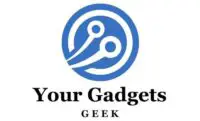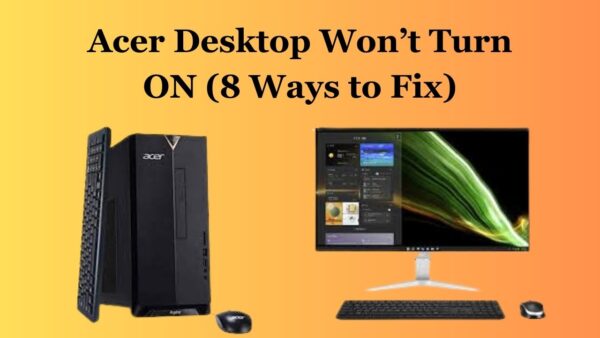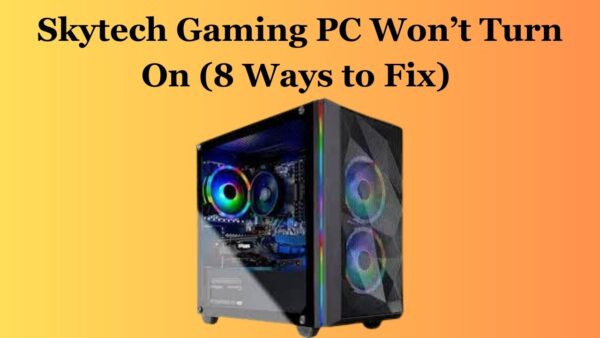Excitement filled me as I eagerly set up my new iBUYPOWER PC. I couldn’t wait to embark on thrilling gaming adventures.
As I connected the HDMI cable from the PC to the monitor, my heart sank. No display and no signs of life.
Panic surged through me as I realized my iBUYPOWER PC was refusing to connect to the monitor, leaving me stranded on the edge of my gaming dreams.
So, I started researching online after hours spent on fixing the error, and finally, I got my PC working back.
In this article, I’ll walk you through the steps as to why your IBUYPOWER PC is not connecting to the monitor and how you can fix it.
Let’s get started!
How to Fix ibuypower PC not Connecting to Monitor
You should try these solutions when your ibuypower PC is not connecting to the monitor.
#1. Change Input Settings
Most computers & monitors come with different input and output sources, such; as HDMI, VGA, DVI or Display Ports.
If you’ve not selected the correct input source for your monitor, it can be the reason for your PC to not connect with the monitor.
So, you should change your computer input source using the input button. However, the menu button will work if your monitor doesn’t have an input key.
Press the menu key from the monitor and then select the same input source where you’ve inserted the cable.
For example, if you’ve connected the monitor using an HDMI port, but the input is selected on VGA, the display will not work.
You should select the HDMI as your input source, and it should resolve the problem.
#2. Check Cable Connections
Overtimes the cables connected to your computer can lose and cause the problem. So, you should check all power and display cords to ensure they are securely connected.
If you suspect loose cables, you should insert them all the way into the port. Also, you can reset the cable connections.
You should disconnect all connected devices and cables and then plug them back in firmly. It will help you to resolve the issues.
#3. Check the Display Cable
Another reason for your PC can be a faulty or damaged display cable. If your HDMI or other cables that you are using to connect the PC to the monitor are faulty, you may run into trouble.
So, you should check the display cable carefully. If you find the cord damaged, you should replace it and get your problem solved.
You can also use another display cable to ensure the old cable isn’t faulty. You should follow the next steps if the new cable doesn’t resolve.
#4. Clean/ Use other Port
If you’re an old PC, the computer display ports can be dirty, overtime dirt can accumulate in the ports and prevent the signals from passing through.
So, you should check and clean your HDMI or other display ports to fix th
#5. Troubleshoot the Computer
If your display cables and ports malfunction, you should check the monitor and system with a different device.
Firstly if you’ve another monitor, you can plug it into your PC and check if it connects successfully.
However, if the PC doesn’t work with another monitor, you should check the monitor or take it to an expert.
On the other hand, you should test your monitor with a new PC. Connect all the display or power cables firmly and check whether it connects.
Once you’ve found the problematic device, you can troubleshoot it in different ways.
#6. Check RAM Sticks
If your PC is showing a red LED indicator and not displaying on the monitor, you should pay attention to the RAM sticks.
RAM is short-term PC memory and helps the computer processor run applications or open files.
If the RAM is faulty, it can prevent the computer from booting up, loading or opening the applications.
So, you should check your RAM sticks installed on the PC and troubleshoot the faulty one.
Here is how you can do so:
1. Turn off the PC and unplug the power adapter for safety purposes.
2. Open the side panel to access the internal components.
3. Remove all the connected RAMs from the motherboard.
4. And then insert one RAM into the slot, then turn on your PC. If the computer turns on and connects with your monitor, you should repeat the process for all RAM sticks until you find the problem.
5. Once you find a faulty RAM stick, you can troubleshoot it.
When you find the faulty memory, turn off the PC and remove all the faulty and all the other ones. Insert the faulty RAM into the first slot you’ve checked is working correctly.
And then turn on your PC. If it works, then your RAM slot is faulty, and you need to get it checked by an expert.
However, if the PC still shows an error after swapping the RAM slot, the particular RAM stick is faulty, and you can check it again after cleaning it with a lint-free cloth or rubbing alcohol.
#7. Check Graphics Card
Sometimes a dedicated graphics card can be a potential reason for your computer to not connect/ display on the monitor.
You should check your graphics card to ensure it is not preventing the PC from connecting.
So, you should remove/ disconnect the graphics card from the motherboard and then plug the HDMI or DP cable into the motherboard port.
And the other end of the cable inserts firmly into the monitor’s display port to check if the problem is resolved and if it works.
If the computer connects with the monitor, then your graphics card may be a possible reason for this problem.
#8. Enable Motherboard HDMI
If you’ve built a PC and have a dedicated graphics card, then your motherboard HDMI port will automatically be disabled.
And results in the PC cannot connect to the monitor; if you want to use your motherboard display ports for PC connection, you should enable it from the device settings.
Here is how you can enable your motherboard’s display ports:
1. Restart your PC and then press the F2, Esc, F8 or F12 to enter the device to the BIOS.
2. Once you are in BIOS, go to the Advanced option.
3. Then System Agent Configuration.
4. Select Graphics Configurations.
5. Here, Enable the CPU Graphics Multi-Monitor.
6. Once you’ve done this, click on Exit and Save Change & Reset.
7. In a few minutes, your PC will be reset, and then unplug it from the outlet.
8. Insert the display cable into your motherboard’s HDMI, DP or VGA ports.
After this, plug the power adapter back into the power outlet and turn on your monitor. It should resolve the problem.
#9. Contact Customer Support
If you’ve tried all the troubleshooting from this article, but your PC is still not connecting to the monitor, you can contact the ibuypower PC customer support.
The customer support team will be able to help you with this problem and provide other possible solutions.
Final Words
These are a few possible solutions that will help to resolve your ibuypower PC:
- Change Input Settings
- Check Cable Connections
- Check the Display Cable
- Clean/ Change Display Port
- Troubleshoot the Computer
- Check Graphics Card
- Enable Motherboard HDMI
Now I’d like to hear from you!
Which method from this article helped you to resolve your ibuypower PC?
Let me know in the comment.
You May Also Like Reading:
CyberPower PC Not Connecting to Monitor



